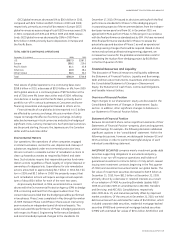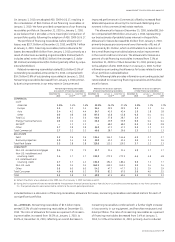GE 2010 Annual Report Download - page 57
Download and view the complete annual report
Please find page 57 of the 2010 GE annual report below. You can navigate through the pages in the report by either clicking on the pages listed below, or by using the keyword search tool below to find specific information within the annual report.management’s discussion and analsis
GE 2010 ANNUAL REPORT 55
the FDIC for any amounts that the FDIC pays to holders of GECC
debt that is guaranteed by the FDIC.
We securitize financial assets as an alternative source of
funding. On January 1, 2010, we adopted ASU 2009-16 & 17, which
resulted in the consolidation of $36.1 billion of non-recourse
borrowings from all of our securitization QSPEs. During 2010, we
completed $10.3 billion of non-recourse issuances and had
maturities of $22.3 billion. At December 31, 2010, consolidated
non-recourse borrowings were $30.1 billion. We anticipate that
securitization will remain a part of our overall funding capabilities
notwithstanding the changes in consolidation rules described in
Notes 1 and 24.
Our issuances of securities repurchase agreements are insig-
nificant and are limited to activities at certain of our foreign banks.
At December 31, 2010 and 2009, we were party to repurchase
agreements totaling insignificant amounts, which were accounted
for as on-book financings. We have had no repurchase agree-
ments which were not accounted for as financings and we do not
engage in securities lending transactions.
We have deposit-taking capability at 10 banks outside of the
U.S. and two banks in the U.S.—GE Money Bank, a Federal Savings
Bank (FSB), and GE Capital Financial Inc., an industrial bank (IB). The
FSB and IB currently issue certificates of deposit (CDs) distributed
by brokers in maturity terms from three months to ten years.
Total alternative funding at December 31, 2010 was $60 billion,
composed mainly of $37 billion of bank deposits, $11 billion of
funding secured by real estate, aircraft and other collateral and
$9 billion of GE Interest Plus notes. The comparable amount at
December 31, 2009 was $57 billion.
EXCHANGE RATE AND INTEREST RATE RISKS are managed with a
variety of techniques, including match funding and selective use
of derivatives. We use derivatives to mitigate or eliminate cer-
tain financial and market risks because we conduct business in
diverse markets around the world and local funding is not
always efficient. In addition, we use derivatives to adjust the
debt we are issuing to match the fixed or floating nature of
the assets we are originating. We apply strict policies to man-
age each of these risks, including prohibitions on speculative
activities. Following is an analysis of the potential effects of
changes in interest rates and currency exchange rates using
so-called “shock” tests that model effects of shifts in rates.
These are not forecasts.
• It is our policy to minimize exposure to interest rate changes.
We fund our financial investments using debt or a combination
of debt and hedging instruments so that the interest rates of
our borrowings match the expected interest rate profile on our
assets. To test the effectiveness of our fixed rate positions, we
assumed that, on January 1, 2011, interest rates increased by
100 basis points across the yield curve (a “parallel shift” in that
curve) and further assumed that the increase remained in
place for 2011. We estimated, based on the year-end 2010
portfolio and holding all other assumptions constant, that our
2011 consolidated earnings would decline by $0.1 billion as a
result of this parallel shift in the yield curve.
• It is our policy to minimize currency exposures and to conduct
operations either within functional currencies or using the
protection of hedge strategies. We analyzed year-end 2010
consolidated currency exposures, including derivatives desig-
nated and effective as hedges, to identify assets and liabilities
denominated in other than their relevant functional curren-
cies. For such assets and liabilities, we then evaluated the
effects of a 10% shift in exchange rates between those cur-
rencies and the U.S. dollar, holding all other assumptions
constant. This analysis indicated that there would be an
insignificant effect on 2011 earnings of such a shift in
exchange rates.
Debt and Derivative Instruments, Guarantees and Covenants
PRINCIPAL DEBT AND DERIVATIVE CONDITIONS are
described below.
Certain of our derivative instruments can be terminated if
specified credit ratings are not maintained and certain debt
and derivatives agreements of other consolidated entities have
provisions that are affected by these credit ratings. As of
December 31, 2010, GE and GECC’s long-term unsecured debt
credit rating from Standard and Poor’s Ratings Service (S&P) was
“AA+” with a stable outlook and from Moody’s Investors Service
(“Moody’s”) was “Aa2” with a stable outlook. As of December 31,
2010, GE, GECS and GECC’s short-term credit rating from S&P
was “A-1+” and from Moody’s was “P-1.” We are disclosing these
ratings to enhance understanding of our sources of liquidity and
the effects of our ratings on our costs of funds. Although we
currently do not expect a downgrade in the credit ratings, our
ratings may be subject to revision or withdrawal at any time by
the assigning rating organization, and each rating should be
evaluated independently of any other rating.
Derivatives agreements:
Swap, forward and option contracts are executed under standard
master agreements that typically contain mutual downgrade
provisions that provide the ability of the counterparty to require
termination if the long-term credit rating of the applicable
GE entity were to fall below A-/A3. In certain of these master
agreements, the counterparty also has the ability to require
termination if the short-term rating of the applicable GE entity
were to fall below A-1/P-1. The net derivative liability after con-
sideration of netting arrangements, outstanding interest
payments and collateral posted by us under these master
agreements was estimated to be $1.0 billion at December 31,
2010. See Note 22.
























